History of AFSCME Local 1
THE BEGINNING OF LOCAL 1
Desperate times can lead to desperate matters. The early part of the 1930's was very much desperate times. A worldwide depression took its toll and people looked for anything that could alleviate their suffering. It was at this time the Communism and Fascism spread across the world.
Some took advantage of this and began a climbed to greater power. Governor Phillip La Follette saw this. Governor La Follette discussed this with his friend, Alva E. Garey. Garey, who was head of the Civil Service Personnel, understood what the governor was talking about.
The voters would no longer accept the current situation and would demand change. Anyone with an (R) by their name would be voted out of office.
In late 1931, A.E.Garey advised key members of the civil service in Wisconsin. He advised them that unless they do something, the next governor will be forced to replace all of them with people from the DemocraticParty.
These key civil service workers began researching the possibilities of organizing government employees.
An Approach was made to the American Federation of Labor (AFL) in regards to the problems facing government workers.
Special note: The CIO was not yet formed.
The AFL was reluctant to the idea of government workers in unions. These were not people in an industry. There were different trades in each department.
After much discussion and debate, Arnold Zander, from the Bureau of Personnel, approached the AFL with one question; what can we here do?
The AFL knew there was only one answer to this question. The civil service had to organize a union. The AFL charted this new union, first call The Wisconsin State Administrative Employees Association, as federated local 18213 on May 16th, 1932.
The following names appear on this charter: E. E. Gunn Jr., Mrs. Jennie Turner, Arnold S. Zander, Mrs. Mary Trace, Charles Mullen, W. L. Ragartz, Leo Dugan, William Kirsch, Frank R. King and Mrs. Lucile McCarthy.
In June 1932, the association held its first meeting in the Assembly Chambers of the State Capitol. Edgar Gunn Jr. was elected the first president. (It should be now noted that the first membership card went to Mr. Gunn)
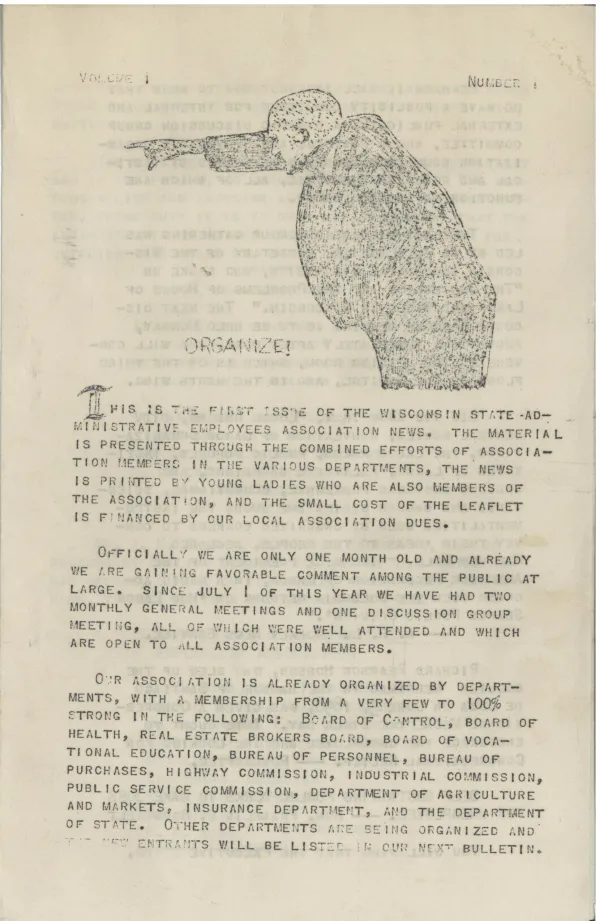
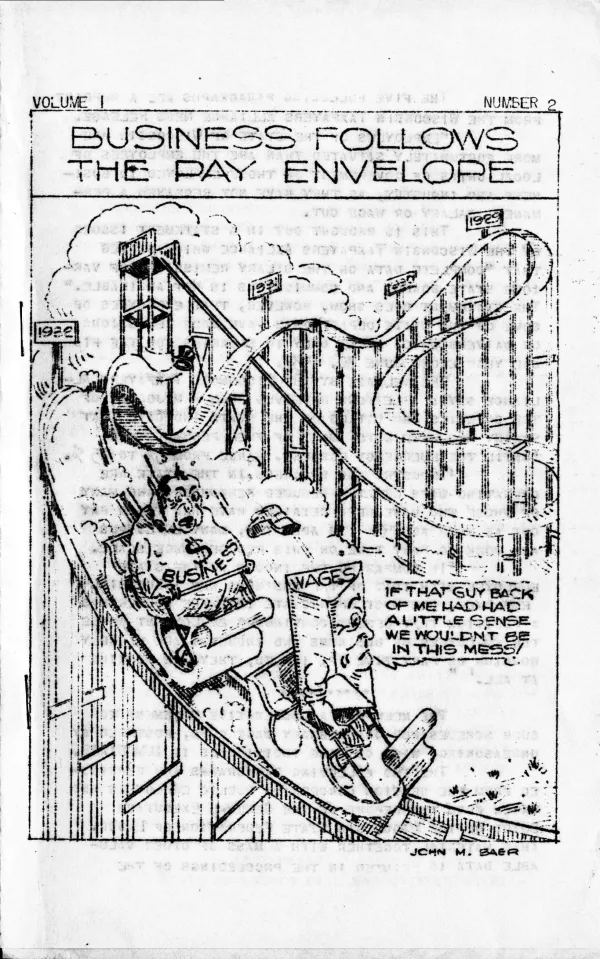
This first step set off a number of other government workers in other states to organize. On August 18, 1932, the American Federation of Government Workers (AFGE) (Fed workers) was founded.
In 1935, Arnold Zander met with other leaders of civil service unions to discuss the formation of a national union. The AFGE claimed jurisdiction.
At the September 1936 convention of AFGE, differences between the needs of the federal workers and the needs of the local government workers were noted. The AFL granted a chartered for a new international union. Local 1 of this new international union was the Wisconsin State Employees Association.
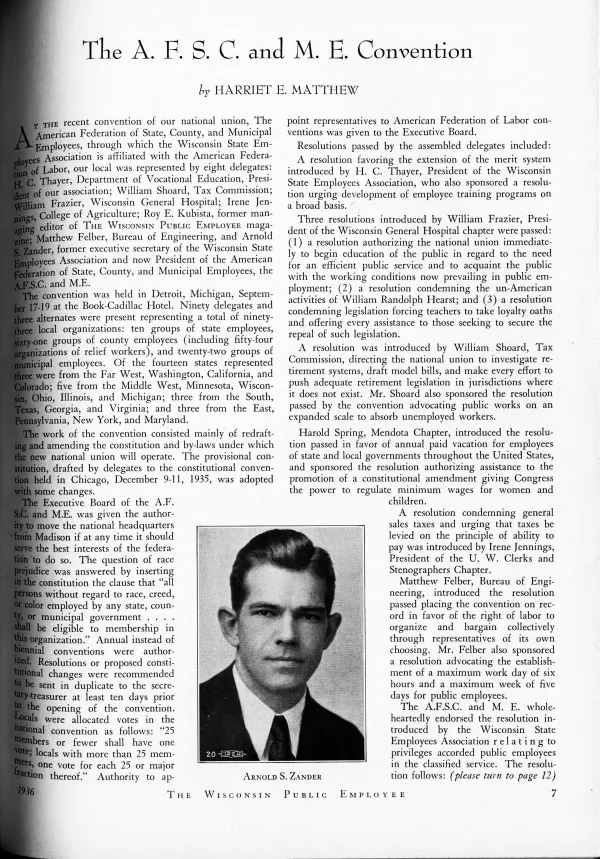
The new international union was called the American Federation of State, County, and Municipal Employees. Arnold Zander was elected president at its first meeting, and the headquarters for this union was in Madison, Wisconsin. (It should be noted that Arnold Zander really did not like this long-winded name for the new international union)
The president of Local 1 was H.C. Thayer. (Note: You' better remember that name because it WILL come up again.)

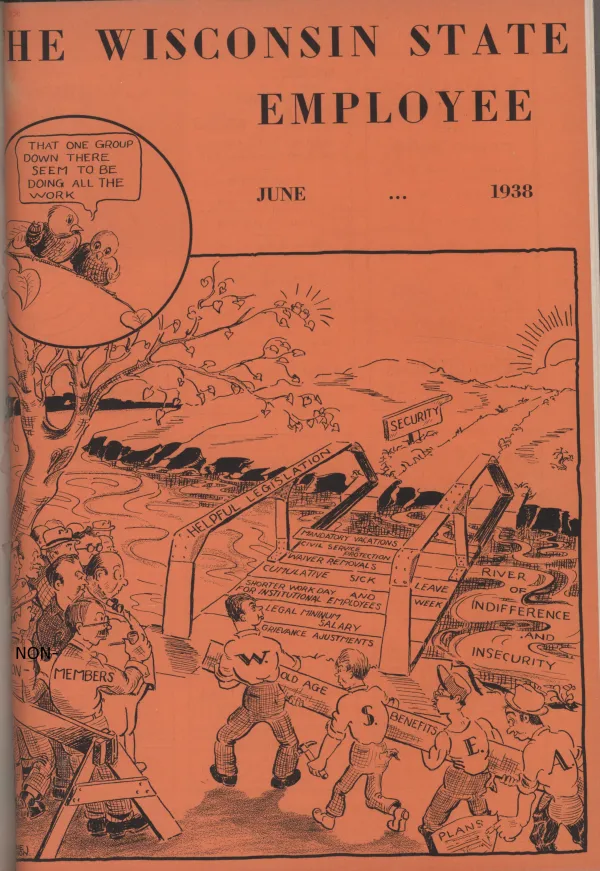

Membership grew in Local 1. By 1942, due to the number of members, the vast geography of the local and significant changes in union structure, Local 1 was broken up. The WSEA became a council (later called WSEU AFSCME Council 24, later merged with the other Wisconsin Councils to form Council 32).
In May of 1942, after the breakup, Harry Thayer was elected president of Local 1. (I told you to remember his name.)
I would now like to pause for a moment for some recap. AFSCME was founded here in Madison, Wisconsin. The First President of the WSEU was Edgar E Gunn Jr. The First President of AFSCME was Arnold Zander. The First president of Local 1 after the break-up was Harry Thayer. The Brain behind all of this fun was Alva Garey.
THE EARLY TRIALS AND TRIBULATIONS
With any organization, there is going to be resistance and a period of trials and tribulations.
The first test came in 1933 with the new legislative body. A bill was proposed to abolish the current civil service system thus bringing back the patronage system. The bill did pass the state assembly, but due to the heavy lobbying efforts made by the new union, the bill failed in the Senate.
Now, believe it or not, an attempt to abolish the civil service system was performed not once but two more times prior to 1942.
Both times, the WSEA lobbied successfully against these bills.
Other successes included obtaining sick leave of 12 days per year, increase in pay, restoration after unfair discharge, 3-week vacations, overtime compensation, etc.
The WSEA was an early supporter of the Child Labor Amendment. It also helped bring about 40 hours work week for government workers.
In the 1930's, there was an attempt to get rid of women in the state civil service after they got married. (I am not making this up) Again, the WSEA fought this piece of unfair legislation.
Beginning as early as 1908, attempts were made to create a pension/retirement plan for state workers.
Session after session, an attempt was made but failed either in the Assembly, the Senate, or in committee.
In 1941, another attempt was made, sponsored by Local 1 to pass legislation for a retirement package for state workers. The bill passed the assembly with only 3 voting against it. However, due to procedure movement, the bill was not voted on by the Senate even though a majority of Senators were supporting it.
1943 was marked as the year of the retirement package by the WSEA.
Roy Kubista, Executive Secretary of WSEA, and member of Local 1 presented another draft of a retirement package. After heavy lobbying, the bill finally passed both the Assembly and the Senate.
However, Governor Walter Goodland vetoed the bill.
The Assembly did override the veto. While the Senate debated on overriding the veto, two ladies decided to visit the governor.
These two ladies, who cleaned the State Capitol Building at night, took it upon themselves to visit the governor and have a little chit-chat with him.
These two ladies were Ingeborg Sidwell and Katherine Conlin. Mrs. Sidwell was a young lady at the time, she was 80. Mrs. Conlin was even younger at age 71. These ladies explained to the governor that they did scrimp to save, but lost their money when a bank crashed. Now they did explain to the governor that they were alright and had a plan of their own. However, they did explain to the governor that food and doctor care was expensive. Besides they told him that they were getting too old to continue scrubbing the capitol floors. Ingeborg referred to herself as a stubborn Norwegian but then mention to the governor that he was a Republican and that Republicans could always find some extra money in some corner for a worthy plan.
A rarity in the history of American politics, how many times has a president or a governor done the following. The governor looked over the numbers that night and the next morning called the Senate, informing them that he desired to recall his veto and sign the bill. The bill was voted on by the Senate and the governor's veto was overridden.
Roy Kubista continued working on improving the retirement system until his death in 2001.
In Civil rights, Local 1, in an editorial, mention the unfair treatment of people in this country based on race. Local 1 fought for civil rights for all people from the beginning of this union.
It was even an advocate for the disabled.
Local 1 was involved in the process of health insurance for state workers.
Local 1 has been through many trials and tribulations. It has always fought through such adversity.
Yet, Local 1 still went on, fighting not the fights it can win, but the fights that must be fought.
Higher wages, better benefits, and safer working conditions are just a few of the issues Local 1 is currently working on.
From the first president, Edgar Gunn Jr, to the current President, Vern Seay, local 1 has consistently been on the front lines of the labor movement.
Local 1 has been forced out of some towns in Wisconsin through a threat of violent retribution, but Local 1 is still here. (Beaver Dam, 1936)
Local 1 has been banned at one point from some towns, yet, Local 1 still exists. (Waupun, 1934)
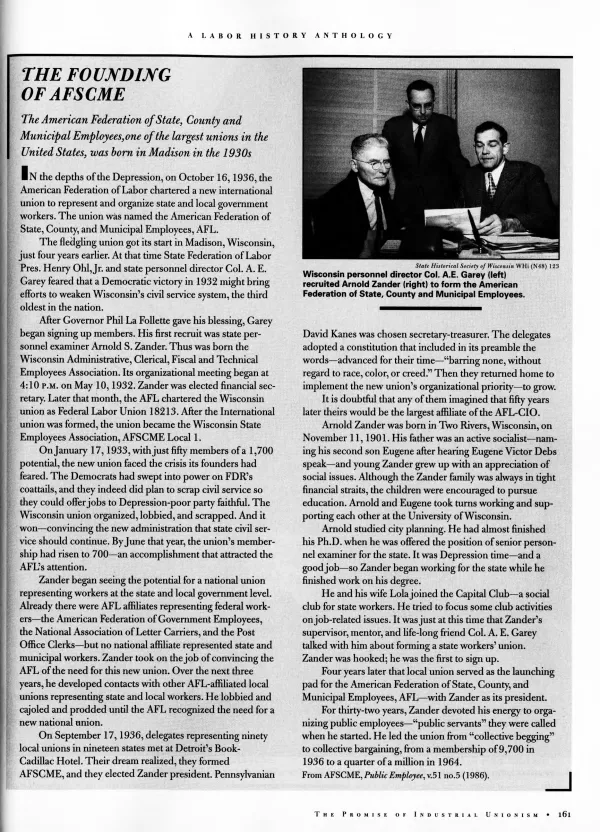
WHAT CAN WE HERE DO?
With every problem that comes to Local 1, one question is asked, one way or another; what can we here do?
This question refers to what the people, that are present in that room, can do?
FINAL NOTES
Many famous people have done business with local 1. All of the Governors of Wisconsin since Phillip La Follette's first term, Senators, Congressmen, etc.
Local 1 has received letters from people such Senator Joe McCarthy, and Robert La Follette Jr. (these were friendly letters)
Local 1 had a candidate for Governor, named Gaylord Nelson, address Local 1's meeting.
Local 1 even introduced a young Assemblyman, named Fred Risser, in 1956.
Local 1 has had its meetings in the oddest of places. From a damped basement of an apartment building that was dubbed the bat-cave, to the headquarters of AFSCME International and finally the Assembly Chambers of the State Capitol.
It was even recommended at one time by a member of Local 1 Executive Board that the general membership meeting take place in a vacant brewery vat just to increase membership attendance.
It has been over 40 years since a member of Local 1 was President of AFSCME International, but it reminds a least one high ranking person every year on where this union was born.
Local 1 does this, not to boast, but educate and remind why this union must go forward and fight.
Local 1 seeks to improve itself and the union, for Local 1 knows that in the civil service, The best shall serve.
If Local 1 ever fails, others will fall like a set of dominos We are the keystone. We are AFSCME. We are the Association. We are Wisconsin. We are Local 1!
In Solidarity and Fraternally Yours
Bob Walker
